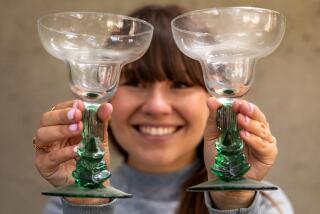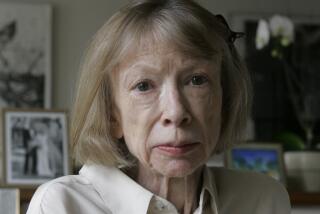Auctions Bidding for Trade
- Share via
STOCKHOLM, Sweden — The bidding at Bukowskis, one of Europe’s most famous auction houses, had been brisk for almost an hour, but a crest of genuine auction fever swept through the crowded salon when a canvas by Swedish painter Carl Larsson came to the block.
It was the first big-ticket item offered that first day of Bukowskis’ four-day international auction, one of five major auction events held annually.
The 1884 painting was Larsson’s portrait of a solitary woman wearing a red hat, wrapped in a waist-length, white, fur cloak and walking down a narrow, almost desolate, country path. The painting’s value was about $645,160, but the bidding soared well beyond before it was purchased.
Even for those in the audience who aren’t bidding, the excitement is contagious. Stockholm’s auction houses are part history, part sport and lots of fun.
Enormously popular and well-publicized, the auctions attract a wide range of international clientele, including European royalty.
Even for only observers of the ritual, there are wonderful works of art, antiques and fascinating bidders to watch. Sometims people get caught up in the action and walk away with a once-in-a-lifetime purchase that may or not be a bargain.
Bidding is in Swedish, but it is not difficult to follow the action. If it is, help can be received from other participants who are more than willing to translate.
Some auctions run for several days and include many kinds of collectibles. Others are one day and focus on special themes such as coins, military medals, painted furniture and rare books.
The four-day Bukowskis sale also featured a sought-after canvas by playwright/painter August Strindberg: a somewhat surrealistic landscape of a lighthouse jutting from a rock into a cloudy, brooding sky. It was valued at about $2.66 million.
Other popular paintings included a portrait by Eva Bonnier, wildlife canvases by Bruno Liljefors, nudes in countryside settings by Anders Zorn and daily-life scenes by Larsson.
These and other works--a total of 356 oils, watercolors, drawings, prints and sculptures--were from about $3,225 to $1.29 million.
During the event’s last three days Bukowskis put famous oils, as well as furniture, objets d’art, silver, jewelry and carpets, on the block for from $325 to $645,000.
The auction tradition is an old one in Sweden. Although auctions probably originated in the Orient, auctions became regulated in Sweden in 1664.
Bukowskis, along with Beijers Auktioner and Stockholms Auktionsverket, have given Stockholm its international auction reputation.
The three auction houses close down during the summer, when most Swedes vacation, but operate frequently during the rest of the year.
Stockholms Auktionsverket (Jakobsgatan 10, Box 16256, S-10325 Stockholm) is the most popular and affordable of the three. It offers the broadest range of merchandise.
Founded in 1674, it is one of Europe’s oldest auctioneers. Its history includes the sale of the Swedish royal family’s unwanted properties and spoils of war during the 17th and 18th centuries.
Auction items include turn-of-the-century furniture, fur coats, 10-speed bikes, boxes of antique buttons, pianos and porcelain. Sessions take place weekdays from 9 a.m. to noon and occasionally in the afternoon.
A classic-cars sale each April, and a toys and dolls sale held annually before Christmas are among its most popular events.
Prices on items sold at Stockholm’s Auktionsverket generally are about $100 to $10,000, with the average cost $300. Schedules will be sent upon request. Auction catalogues, about $4 to $20 U.S. each, are available about three or four weeks before sales and can be mail ordered.
Bukowskis (Arsenalsgatan 8, S-11147 Stockholm) began auctioning fine art in 1870. Founded by Henrik Bukowski, a Polish nobleman who emigrated to Sweden in the 1860s, the house concentrated on art often obtained from family friends, including royalty. At one of its first auctions, Bukowskis sold much of the art collection of the Swedish King Karl XV, who died in 1873.
Bukowskis now controls about 55% of Stockholm’s auction sales of high-end paintings and antiques. Famous paintings may fetch millions of dollars but the average cost for a canvas is about $75,000; you can buy lesser-known works for investment for about $8,000.
Antique furniture, too, can be purchased for investment, especially pieces such as Georg Haupt’s 1778 marquetry bureau with marble top and gilded edges, which recently sold for more than $1.9 million.
In addition to its five major annual auctions, Bukowskis schedules a monthly auction of quality paintings at its gallery on Strandvagen. Schedules will be sent upon request and catalogues filled with color photographs are sold by subscription for about $60 a year (overseas rate) for all of the year’s major auctions.
Beijers Auktioner (Birger Jarlsgatan 6, S-11434 Stockholm) was founded in 1984 by former Bukowskis employees. The house competes with Bukowskis for sale of works by famous Swedish masters, including Liljefors and Zorn, fine antique furniture, jewelry and objets d’art. Beijers also specializes in lesser known artists who may have high investment potential, such as Carl Frederick Hill and Pettar Lilja.
Beijers stages six auctions a year--three in spring and three in fall. Auctioned items must be worth at least $850. Less expensive objects are sold at Decorativa Auktioner, a subsidiary at Strandvagen 9 near Hotel Diplomat.
Auction schedules are sent upon request. Catalogues with color reproductions cost about $16 each. Beijers accepts overseas telephone bids.
More to Read
The biggest entertainment stories
Get our big stories about Hollywood, film, television, music, arts, culture and more right in your inbox as soon as they publish.
You may occasionally receive promotional content from the Los Angeles Times.










